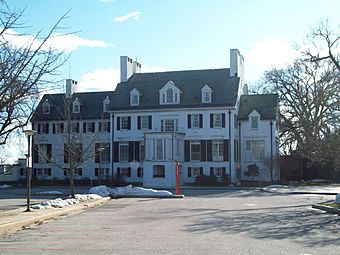Hilton (Catonsville, Maryland) facts for kids
Quick facts for kids |
|
|
Hilton
|
|

Hilton, December 2009
|
|
| Location | 800 S. Rolling Rd., Catonsville, Maryland |
|---|---|
| Area | less than one acre |
| Built | 1825 |
| Architect | Palmer, Edward |
| Architectural style | Colonial Revival, Georgian Revival |
| NRHP reference No. | 80001794 |
| Added to NRHP | October 31, 1980 |
Hilton is a historic house located at The Community College of Baltimore County in Catonsville, Baltimore County, Maryland. It's a grand house built in the early 1900s in the Georgian Revival style. It was created from an older stone farmhouse from around 1825. The house overlooks the beautiful Patapsco River valley.
The famous Baltimore architect Edward L. Palmer, Jr. designed the changes to the house in 1917. The main part of the house is very long, with two and a half stories and a special gambrel roof. There's also a two-and-a-half-story section extending from one side and a smaller two-story section on the other. The roof is covered with strong Vermont slate. The house also has a small enclosed porch that might have been used as a covered entrance for carriages.
Contents
The History of Hilton House
Hilton House sits on land that was once part of a huge area called "Taylor's Forest." This land was first surveyed way back in 1678.
Early Owners and Naming
The first building on this 511-acre site was a stone farmhouse. It was built between 1818 and 1825 for a man named James W. McCulloh. In 1825, the property was sold to John Lewis Buchanan.
Then, in 1827, Dr. Lennox Birckhead bought the property. He was the son of McCulloh's business partner. Dr. Birckhead decided to name his new home "Hilton." He chose this name because the house was built on a high spot, giving it great views.
Changes Through the Years
In 1837, William Carson Glenn bought Hilton. He later sold it to his brother, John Glenn, who was a politician, in 1842. During this time, important guests like Robert E. Lee visited the house. In 1852, John Glenn added more stone buildings around the property.
The property later went to Marrietta Glenn. It was managed by William Wilkens Glenn, who published newspapers. During the American Civil War, William Glenn supported the Southern states. Hilton was sometimes used as a safe stop for people from the South who were trying to escape Union troops. William Glenn passed away in 1876, and the farm was not used much after that.
New Beginnings and Community Use
By 1905, the large estate was divided into 25 smaller pieces of land. In 1907, 43 acres were given by John Mark Glenn to help create the first part of Patapsco Valley State Park.
In 1917, George Worth Knapp, who owned a company called National Enameling and Stamping Company, bought Hilton. He wanted it as a summer home and a dairy farm. He brought together about 105 acres of the original estate.
Later, in 1962, the Baltimore County Public Schools bought the property. They wanted to use it to start a branch of the Community College of Baltimore County. In the 1970s, the mansion itself was used for college classes. In 2011, money was given to fix up the building. The plan was to turn it into the Center for Global Education.
Historic Outbuildings
Besides the main Hilton Mansion, there are other old buildings on the property. These buildings date back to the time when the farm was active. There are two stone houses built in 1852 in the Tudor style. One of them is now in ruins. There's also a stone bowling alley from 1852 that is also in ruins. Finally, there's a stone building that was used by gardeners.
Hilton was officially added to the National Register of Historic Places in 1980. This means it's recognized as an important historical site.
Images for kids




